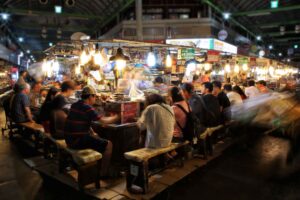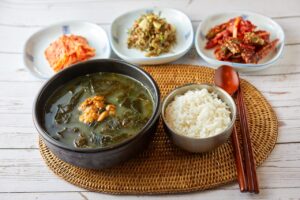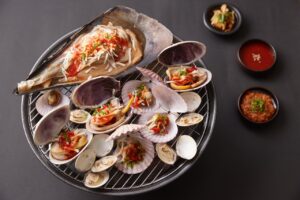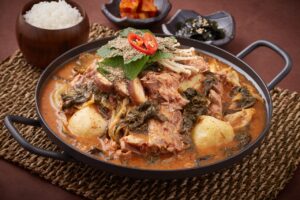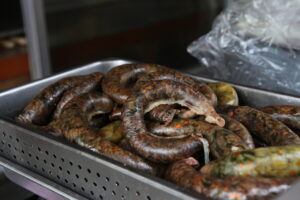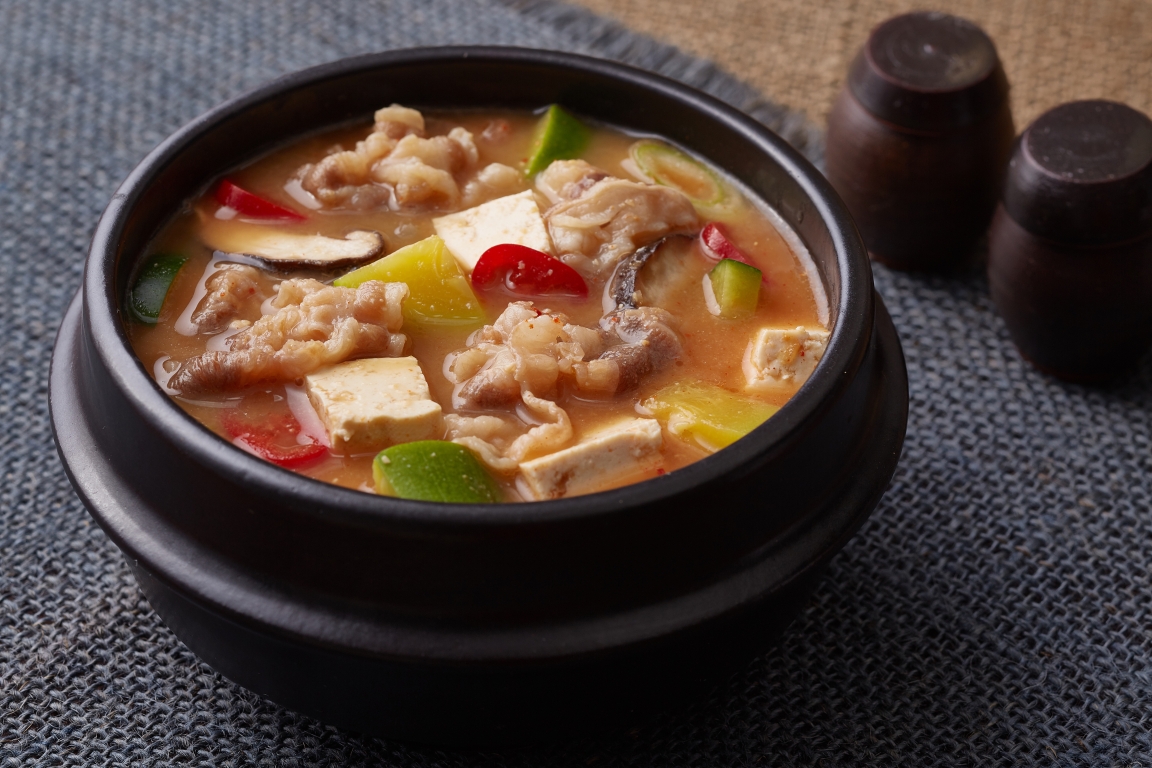
Doenjang Jjijae ⓒ한국관광공사 사진갤러리-디그램
What is Doenjang?
Doenjang (된장) is a traditional Korean fermented soybean paste that plays a central role in Korean cuisine. It’s a versatile and essential ingredient used in various dishes to add depth of flavor and umami.
It has a long history in Korean culinary traditions and is a fundamental component of many Korean dishes. Here’s more about doenjang:
Ingredients and Fermentation: It is made by fermenting soybeans, often along with other grains like barley or rice, with the help of a specific type of mold called Aspergillus oryzae. The fermentation process can take several months to develop the rich flavors and complex aromas that characterize doenjang.
Varieties and Types: There are different varieties one, which can vary in taste, color, and consistency based on factors such as the ingredients used, the duration of fermentation, and regional preferences. Some common types of doenjang include:
- Regular : This is the most common type of doenjang and is typically used as a base for soups, stews, and sauces.
- Mild : Some varieties are milder in flavor, which can be suitable for those who prefer a less intense taste.
- Soybean-Rice : This type is made by fermenting a mixture of soybeans and rice. It has a slightly sweeter flavor and lighter color.
Uses in Cooking: it is a fundamental ingredient in Korean cuisine, and its uses are diverse:
- Soups and Stews: It is often used as a base for Korean soups and stews, such as doenjang jjigae (fermented soybean paste stew) and tteokguk (rice cake soup).
- Sauces: It’s used to make ssamjang (a dipping sauce for wraps), dipping sauces for vegetables, and marinades for grilled meats.
- Flavor Enhancer: It adds depth and complexity to a wide range of dishes, enriching the overall flavor profile.
- Side Dishes: It’s also used to make banchan (side dishes), such as doenjang banchan, which are small dishes served alongside rice.
- Noodles: Doenjang-based sauces are used as toppings for various noodle dishes.
Health Benefits: It is not only flavorful but also nutritious. It’s a source of protein, fiber, and essential amino acids. Additionally, it contains probiotics that are beneficial for gut health.
Cultural Significance: It holds cultural significance as a staple in Korean kitchens. It’s considered a fundamental ingredient that connects modern generations to the culinary traditions of their ancestors.
What is difference between Deonjang and Miso?
Doenjang and miso are both fermented soybean pastes used in Asian cuisines, but they originate from different cultures and have distinct flavors and characteristics. Here are the key differences between doenjang and miso:
Origin and Culture:
- Doenjang: It is a traditional Korean fermented soybean paste. It has been a staple of Korean cuisine for centuries and plays a fundamental role in many Korean dishes.
- Miso: Miso is a Japanese fermented soybean paste that is an integral part of Japanese cuisine. It has a long history in Japanese culinary traditions and is used in a variety of Japanese dishes.
Ingredients and Fermentation:
- Doenjang: It is made by fermenting soybeans, often with other grains like barley or rice, using a specific type of mold called Aspergillus oryzae. The fermentation process takes several months to develop the desired flavors.
- Miso: Miso is also made from fermented soybeans, along with grains like rice or barley. The fermentation process involves different strains of mold, depending on the type of miso being produced. The duration of fermentation varies and can result in different flavors and colors.
Flavor and Taste:
- Doenjang: It has a robust, savory, and deep flavor profile with a rich umami taste. It has a complex aroma and can range from slightly salty to more intense, depending on the type and duration of fermentation.
- Miso: Miso has a range of flavors, from sweet and mild to salty and intense, depending on the type of miso. Generally, white miso (shiro miso) is milder and slightly sweet, while red miso (aka miso) is stronger and saltier.
Color and Texture:
- Doenjang: It is typically darker in color, ranging from brown to dark reddish-brown. It has a thick and hearty texture.
- Miso: Miso varies in color, from light beige (white miso) to deep reddish-brown (red miso). The texture can also vary, with white miso being smoother and softer, while red miso is denser.
Culinary Uses:
- Doenjang: It is a fundamental ingredient in Korean cuisine. It’s used to make soups, stews, sauces, marinades, and side dishes, contributing to the savory and umami flavors of the dishes.
- Miso: Miso is a versatile ingredient in Japanese cuisine. It’s used to make miso soup, dressings, marinades, glazes, and more. Miso also plays a significant role in traditional Japanese dishes like miso ramen.
What is Meju?

Meju (메주):Meju is a term in Korean cuisine that refers to fermented soybean blocks or bricks. It is a key ingredient in the production of various Korean fermented foods, such as doenjang (fermented soybean paste) and ganjang (soy sauce). Meju serves as the starting point for the fermentation process, as it provides the foundation of flavors and enzymes that develop over time.
The process of making meju involves cooking and fermenting soybeans.
The basic steps are as follows:
Soaking: Soybeans are soaked in water to rehydrate them.
Boiling: The soaked soybeans are boiled until they become soft and plump.
Mashing: The cooked soybeans are mashed or ground into a paste-like consistency.
Shaping: The mashed soybeans are shaped into rectangular blocks or bricks.
Fermentation: The meju blocks are left to ferment in a controlled environment. During fermentation, natural microorganisms, including molds and bacteria, develop on the surface of the blocks. These microorganisms play a crucial role in breaking down the soybeans and creating the complex flavors of the final products, such as doenjang and ganjang.
Drying: After fermentation, the meju blocks are typically sun-dried or air-dried to reduce moisture content and stabilize the fermentation process.
Meju serves as a basis for creating various fermented foods in Korean cuisine:
Doenjang: Meju blocks are used to make doenjang, the traditional fermented soybean paste. The meju blocks are combined with salt and other ingredients and allowed to ferment further, resulting in the rich and savory doenjang paste.
Ganjang: Meju blocks can also be used to produce ganjang, the traditional soy sauce. The blocks are soaked in brine, and the resulting liquid is then aged to develop the flavor of soy sauce.
Chungkukjang: As mentioned earlier, meju blocks are used to make chungkukjang, another type of fermented soybean paste with a distinct pungent flavor.
Meju is an essential ingredient in Korean fermentation traditions, contributing to the unique flavors and characteristics of various fermented foods. The process of making meju requires skill and experience, and it is an important part of preserving Korean culinary heritage.
What is Ganjang and Chungkukjang?
Ganjang (간장): Ganjang is a traditional Korean soy sauce that is widely used as a seasoning and flavoring agent in Korean cuisine. It’s a fundamental ingredient that adds depth of flavor and umami to various dishes. Ganjang is made through a fermentation process involving soybeans, water, salt, and a specific type of mold known as Aspergillus oryzae. The mixture is left to ferment and age, resulting in the development of rich and complex flavors.
There are different types of ganjang, including:
- Joseon Ganjang: Also known as traditional soy sauce, this type of ganjang is aged for a longer period and has a deep and robust flavor.
- Guk Ganjang: This is a lighter and milder soy sauce that is often used for making soups and broths.
- Jin Ganjang: Jin ganjang is a type of premium soy sauce made with high-quality ingredients. It has a more delicate and refined flavor.
Ganjang is used as a seasoning in various Korean dishes, including soups, stews, marinades, dipping sauces, and stir-fries. It’s an essential ingredient in Korean cooking, contributing to the umami and savory notes that are characteristic of Korean cuisine.
Chungkukjang (청국장): Chungkukjang is a type of fermented soybean paste that shares similarities with doenjang but is produced through a different fermentation process. While doenjang is made with the addition of specific molds and fermented grains, chungkukjang is typically made with just soybeans and water. The fermentation process of chungkukjang results in a strong and distinct flavor, often described as pungent and intense.
Chungkukjang is known for its potent aroma and deep umami taste. It’s often used as a base for soups, stews, and sauces, particularly in Korean temple cuisine. Due to its strong flavor, chungkukjang is used in smaller quantities compared to other soybean pastes like doenjang.
Both ganjang and chungkukjang are essential components of Korean cuisine, contributing to the complexity of flavors and the overall taste profile of a wide range of dishes.
What kinds of Korean Food?
Doenjang, the traditional Korean fermented soybean paste, is a versatile and essential ingredient used in a wide range of Korean dishes. Its rich umami flavor and depth contribute to the complexity of flavors in these dishes. Here are some popular foods that are made using doenjang:
- Doenjang Jjigae (된장찌개): Doenjang jjigae is a classic Korean stew made with It as the base. It often includes tofu, vegetables, mushrooms, and sometimes seafood or meat. That imparts a rich and savory flavor to the stew.
- Ssamjang (쌈장): Ssamjang is a dipping sauce made with It, gochujang (red chili paste), garlic, sesame oil, and other seasonings. It’s commonly used as a condiment for wraps (ssam) made with lettuce or other greens.
- Guk (된장국): Doenjang guk is a simple soup made by dissolving doenjang in water to create a flavorful broth. It’s often served with rice and side dishes.
- Banchan: It can be used as a seasoning or flavoring agent for various side dishes (banchan). For example, blanched vegetables can be coated with a doenjang-based sauce.
- Fried Rice: It can be used to season fried rice, adding a rich and savory taste to the dish.
- Marinated Meat: Doenjang can be used as a marinade for various proteins like beef, pork, or chicken. The marinade imparts a deep, savory flavor to the meat.
- Noodles: Doenjang-based broths can be used to create flavorful noodle dishes, such as doenjang ramen or noodles.
- Stew with Seafood (Haemul Doenjang Jjigae): This variation of doenjang jjigae includes a mix of seafood like shrimp, clams, and squid, adding a seafood dimension to the dish.
- Grilled Vegetables: Doenjang can be used as a glaze or marinade for grilled vegetables, enhancing their flavor.
- Doenjang Sauce for Bibimbap: Doenjang can be mixed with other ingredients to create a flavorful sauce for bibimbap, a popular Korean mixed rice dish.
- Doenjang-based Dipping Sauce: Doenjang can be combined with vinegar, sesame oil, and other seasonings to create a dipping sauce for vegetables, dumplings, or meats.
These are just a few examples of the many dishes and foods that incorporate doenjang as a central ingredient. Its versatile and savory nature makes it a key component of Korean cuisine, adding depth and richness to a variety of culinary creations.
Place for Doenjang Jjigae in Korea.
Munchulrae Doenjang 3-6, Jungang-daero214beon-Gil, Busan South Korea
Recommend to Read >> Makgeolli, the Harmony of Korean Food and Liquor – 2023
